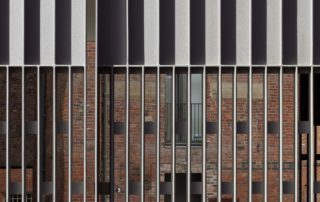FCB Studios has completed a landmark residential development in the heart of Manchester’s Ancoats Conservation Area
FCB Studios’ transformation of Murrays’ Mills for developer Manchester Life is a flagship residential project that forms part of the regeneration of Manchester’s Ancoats Conservation Area. Murrays’ Mills is the oldest surviving steam-powered cotton mill in the world, writes FCBStudios. Our first task was an analysis of the existing historic structures to determine how many dwellings could be created without disturbing the fabric of the buildings, writes FCBStudios. In responding to the site rather than a pre-set notion of unit numbers ensured that the character and heritage would be preserved. Manchester Life has restricted sales to owner-occupiers, ensuring that the next chapter of Murrays’ will be locally owned.
Originally built in 1798, the industrial complex comprises two parallel 7-8-storey mills linked by a more recognisably Georgian administrative building. A new-build residential building completes the courtyard, which has been transformed from an abandoned canal turning basin to a landscaped garden.
Site plan; ground-floor plan; typical upper floor plan; section
The mix and size of the residential units is derived from careful analysis of the existing building forms and construction. The dwellings comprise 1,2,3 and 4-bedroom apartments, as well as a townhouse in the former engine house building. To make the most of the opportunities available on the site, 28 duplex apartments are provided at ground and roof level.
Within the existing mills, the strategy was to locate the sleeping accommodation on the outside, the services in centre of the plan, and the living spaces overlooking the courtyard. The latter has been re-enclosed by a new building, which takes its form and name – ‘Wing Mill’ – from a predecessor that was destroyed by fire in the 1990s. While modern in character, the design takes its inspiration from the robust, bold and regimented language of the adjacent mill buildings.
Private and communal entrances open directly onto the courtyard to further enliven the shared space. The original circulation cores have been retained, allowing key aspects of the historic fabric to be visible and functional.
While the existing mills are constructed from loadbearing masonry with punctured window openings; the new ‘mill’ is characterised by a contemporary frame structure incorporating framed window openings. The facades consist of a ‘woven’ precast brick lattice infilled with French windows, cast recycled aluminium panels and MIO painted metal balustrades.
The limited material palette extends into the interiors as a means of unifying the whole project, and is supplemented with band-sawn oak floors and simply painted walls. Paint finishes to new steelwork are dark grey, whereas those on existing steel or ironwork are red oxide for clear legibility between old and new.





































